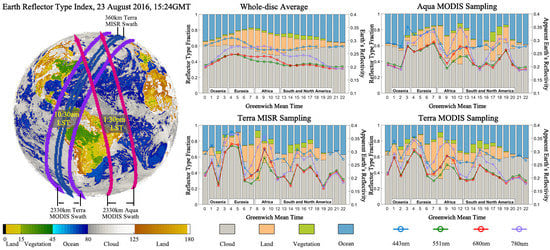Implications of Whole-Disc DSCOVR EPIC Spectral Observations for Estimating Earth’s Spectral Reflectivity Based on Low-Earth-Orbiting and Geostationary Observations
Abstract
1. Introduction
2. Data and Methods
2.1. DSCOVR EPIC Data
2.2. Definitions of Earth’s Spectral Reflectivity
2.3. Sampling Approaches of the Earth Orbiting Satellites (EOS)
2.4. Earth Reflector Type Index
2.5. Definitions of Variation
3. Results and Discussion
3.1. Diurnal Variability
3.1.1. EPIC Scattering Function
3.1.2. Estimates of the Scattering Function from Earth Orbiting Satellites (EOS)
3.2. Daily and Monthly Average Scattering Function
3.3. Reflectivity of Earth Components
3.4. Bidirectional Effects
4. Summary and Conclusions
Supplementary Materials
Author Contributions
Funding
Acknowledgments
Conflicts of Interest
Appendix A. Comment on Equation (2)
Appendix B. Properties of the ERTI
Appendix C. Adjustment of the Cloud–Ocean Threshold
References
- Eck, T.F.; Bhartia, P.K.; Hwang, P.H.; Stowe, L.L. Reflectivity of earth’s surface and clouds in ultraviolet from satellite observations. J. Geophys. Res. Atmos. 1987, 92, 4287–4296. [Google Scholar] [CrossRef]
- Myhre, G.; Shindell, D.; Bréon, F.-M.; Collins, W.; Fuglestvedt, J.; Huang, J.; Koch, D.; Lamarque, J.-F.; Lee, D.; Mendoza, B. Anthropogenic and natural radiative forcing. Climate Chang. 2013, 423, 658–740. [Google Scholar]
- Otterman, J.; Fraser, R.S. Earth-atmosphere system and surface reflectivities in arid regions from landsat mss data. Remote Sensing Environ. 1976, 5, 247–266. [Google Scholar] [CrossRef]
- Stephens, G.L.; Heidinger, A.K.; Gabriel, P.M. Photon paths and cloud heterogeneity: An observational strategy to assess effects of 3d geometry on radiative transfer. In 3d radiative transfer in cloudy atmospheres; Marshak, A., Davis, A., Eds.; Springer: Berlin/Heidelberg, Germany, 2005; pp. 587–616. [Google Scholar]
- Tilstra, L.G.; Tuinder, O.N.E.; Wang, P.; Stammes, P. Surface reflectivity climatologies from uv to nir determined from earth observations by gome-2 and sciamachy. J. Geophys. Res. Atmos. 2017, 122, 4084–4111. [Google Scholar]
- Csiszar, I.; Gutman, G. Mapping global land surface albedo from noaa avhrr. J. Geophys. Res. Atmos. 1999, 104, 6215–6228. [Google Scholar] [CrossRef]
- Kandel, R.; Viollier, M. Observation of the earth’s radiation budget from space. Comptes Rendus Geosci. 2010, 342, 286–300. [Google Scholar] [CrossRef]
- Koelemeijer, R.B.A.; de Haan, J.F.; Stammes, P. A database of spectral surface reflectivity in the range 335–772 nm derived from 5.5 years of gome observations. J. Geophys. Res. Atmos. 2003, 108. [Google Scholar] [CrossRef]
- Stephens, G.L.; O’Brien, D.; Webster, P.J.; Pilewski, P.; Kato, S.; Li, J.-l. The albedo of earth. Rev. Geophys. 2015, 53, 141–163. [Google Scholar] [CrossRef]
- Wielicki, B.A.; Barkstrom, B.R.; Harrison, E.F.; Lee III, R.B.; Louis Smith, G.; Cooper, J.E. Clouds and the earth’s radiant energy system (ceres): An earth observing system experiment. Bull. Am. Meteorol. Soc. 1996, 77, 853–868. [Google Scholar] [CrossRef]
- Marshak, A.; Herman, J.; Szabo, A.; Blank, K.; Carn, S.; Cede, A.; Geogdzhayev, I.; Huang, D.; Huang, L.-K.; Knyazikhin, Y.; et al. Earth observations from dscovr/epic instrument. Bull. Am. Meteorol. Soc. 2018. [Google Scholar] [CrossRef]
- Geogdzhayev, I.V.; Marshak, A. Calibration of the dscovr epic visible and nir channels using modis and epic lunar observations. Atmos. Meas. Tech. Discuss. 2017, 2017, 1–20. [Google Scholar] [CrossRef]
- Herman, J.; Huang, L.; McPeters, R.; Ziemke, J.; Cede, A.; Blank, K. Synoptic ozone, cloud reflectivity, and erythemal irradiance from sunrise to sunset for the whole earth as viewed by the dscovr spacecraft from lagrange-1. Atmos. Meas. Tech. Discuss. 2017, 2017, 1–48. [Google Scholar] [CrossRef]
- Lester, T.P.; McCall, M.L.; Tatum, J.B. Theory of planetary photometry. J. Royal Astronomical Soc. Canada 1979, 73, 233–257. [Google Scholar]
- Yang, W.; Marshak, A.; Várnai, T.; Knyazikhin, Y. Epic spectral observations of variability in earth’s global reflectance. Remote Sensing 2018, 10, 254. [Google Scholar] [CrossRef]
- Huang, D.; Knyazikhin, Y.; Dickinson, R.E.; Rautiainen, M.; Stenberg, P.; Disney, M.; Lewis, P.; Cescatti, A.; Tian, Y.; Verhoef, W.; et al. Canopy spectral invariants for remote sensing and model applications. Remote Sensing Environ. 2007, 106, 106–122. [Google Scholar] [CrossRef]
- Knyazikhin, Y.; Schull, M.; Xu, L.; Myneni, R.; Samanta, A. Canopy spectral invariants. Part 1: A new concept in remote sensing of vegetation. J. Quantitative Spectroscopy & Radiative Transfer 2011, 112, 727–735. [Google Scholar]
- Stenberg, P.; Mõttus, M.; Rautiainen, M. Photon recollision probability in modelling the radiation regime of canopies — a review. Remote Sensing Environ. 2016, 183, 98–108. [Google Scholar] [CrossRef]
- Marshak, A.; Knyazikhin, Y. The spectral invariant approximation within canopy radiative transfer to support the use of the epic/dscovr oxygen b-band for monitoring vegetation. J.Quantitative Spectroscopy Radiative Transfer 2017, 191, 7–12. [Google Scholar] [CrossRef] [PubMed]
- Lewis, P.; Disney, M. Spectral invariants and scattering across multiple scales from within-leaf to canopy. Remote Sensing Environ. 2007, 109, 196–206. [Google Scholar] [CrossRef]
- Zeng, Y.; Xu, B.; Yin, G.; Wu, S.; Hu, G.; Yan, K.; Yang, B.; Song, W.; Li, J. Spectral invariant provides a practical modeling approach for future biophysical variable estimations. Remote Sensing 2018, 10, 1508. [Google Scholar] [CrossRef]
- Marshak, A.; Knyazikhin, Y.; Chiu, J.C.; Wiscombe, W. Spectrally invariant approximation within atmospheric radiative transfer. J. Atmospheric Sci. 2011, 68, 3094–3111. [Google Scholar] [CrossRef]
- Marshak, A.; Knyazikhin, Y.; Chiu, J.C.; Wiscombe, W.J. On spectral invariance of single scattering albedo for water droplets and ice crystals at weakly absorbing wavelengths. J. Quant. Spectrost. Radiat. Trans. 2012, 113, 715–720. [Google Scholar] [CrossRef]
- Baret, F.; Jacquemoud, S.; Hanocq, J.F. About the soil line concept in remote sensing. Adv. Space Res. 1993, 13, 281–284. [Google Scholar] [CrossRef]
- Jacquemoud, S.; Baret, F.; Hanocq, J.F. Modeling spectral and bidirectional soil reflectance. Remote Sensing Environ. 1992, 41, 123–132. [Google Scholar] [CrossRef]
- Knyazikhin, Y.; Schull, M.A.; Stenberg, P.; Mottus, M.; Rautiainen, M.; Yang, Y.; Marshak, A.; Carmona, P.L.; Kaufmann, R.K.; Lewis, P.; et al. Hyperspectral remote sensing of foliar nitrogen content. Proc. Nat. Acad. Sci. USA 2013, 110, E185–E192. [Google Scholar] [CrossRef] [PubMed]
- Latorre-Carmona, P.; Knyazikhin, Y.; Alonso, L.; Moreno, J.F.; Pla, F.; Yan, Y. On hyperspectral remote sensing of leaf biophysical constituents: Decoupling vegetation structure and leaf optics using chris-proba data over crops in barrax. Geosci. Remote Sensing Lett. IEEE 2014, PP, 1–5. [Google Scholar] [CrossRef]
- Féret, J.B.; Francois, C.; Asner, G.P.; Gitelson, A.A.; Martin, R.E.; Bidel, L.P.R.; Ustin, S.L.; le Maire, G.; Jacquemoud, S. Prospect-4 and 5: Advances in the leaf optical properties model separating photosynthetic pigments. Remote Sensing Environ. 2008, 112, 3030–3043. [Google Scholar] [CrossRef]
- Jacquemoud, S.; Baret, F. Prospect: A model of leaf optical properties spectra. Remote Sensing Environ. 1990, 34, 75–91. [Google Scholar] [CrossRef]
- Stubenrauch, C.; Rossow, W.; Kinne, S.; Ackerman, S.; Cesana, G.; Chepfer, H.; Di Girolamo, L.; Getzewich, B.; Guignard, A.; Heidinger, A. Assessment of global cloud datasets from satellites: Project and database initiated by the gewex radiation panel. Bull. Am. Meteorol. Soc. 2013, 94, 1031–1049. [Google Scholar] [CrossRef]
- Gerstl, S.A.W. Building a global hotspot ecology with triana data. P. Soc. Photo Opt. Ins. 1999, 3868, 184–194. [Google Scholar]
- Kuusk, A. The Hot Spot Effect in Plant Canopoy Reflectance. In Photon-Vegetation Interactions: Applications in Plant Physiology and Optical Remote Sensing; Myneni, R.B., Ross, J., Eds.; Springer: Berlin/Heidelberg, Germany, 1991. [Google Scholar]
- Ross, J.K.; Marshak, A.L. Calculation of canopy bidirectional reflectance using the monte-carlo method. Remote Sensing Environ. 1988, 24, 213–225. [Google Scholar] [CrossRef]
- Huang, D.; Knyazikhin, Y.; Wang, W.; Deering, D.W.; Stenberg, P.; Shabanov, N.; Tan, B.; Myneni, R.B. Stochastic transport theory for investigating the three-dimensional canopy structure from space measurements. Remote Sensing Environ. 2008, 112, 35–50. [Google Scholar] [CrossRef]
- Yang, B.; Knyazikhin, Y.; Mõttus, M.; Rautiainen, M.; Stenberg, P.; Yan, L.; Chen, C.; Yan, K.; Choi, S.; Park, T. Estimation of leaf area index and its sunlit portion from dscovr epic data: Theoretical basis. Remote Sensing Environ. 2017, 198, 69–84. [Google Scholar] [CrossRef] [PubMed]
- Matsuyama, H.; Masuda, K. Seasonal/interannual variations of soil moisture in the former ussr and its relationship to indian summer monsoon rainfall. J. Clim. 1998, 11, 652–658. [Google Scholar] [CrossRef]
- Illston, B.G.; Basara, J.B.; Crawford, K.C. Seasonal to interannual variations of soil moisture measured in oklahoma. Int. J. Climatol. 2004, 24, 1883–1896. [Google Scholar] [CrossRef]
- Bedidi, A.; Cervelle, B.; Madeira, J.; Pouget, M. Moisture effects on visible spectral characteristics of lateritic soils. Soil Sci. 1992, 153, 129–141. [Google Scholar] [CrossRef]
- Wu, C.-Y.; Jacobson, A.R.; Laba, M.; Baveye, P.C. Alleviating moisture content effects on the visible near-infrared diffuse-reflectance sensing of soils. Soil Sci. 2009, 174, 456–465. [Google Scholar] [CrossRef]
- Kileshye Onema, J.-M.; Taigbenu, A. Ndvi–rainfall relationship in the semliki watershed of the equatorial nile. Phys. Chem. Earth Parts A/B/C 2009, 34, 711–721. [Google Scholar] [CrossRef]
- Bi, J.; Knyazikhin, Y.; Choi, S.H.; Park, T.; Barichivich, J.; Ciais, P.; Fu, R.; Ganguly, S.; Hall, F.; Hilker, T.; et al. Sunlight mediated seasonality in canopy structure and photosynthetic activity of amazonian rainforests. Environ. Res. Lett. 2015, 10. [Google Scholar] [CrossRef]
- Ross, J. The Radiation Regime and Architecture of Plant Stands; Dr W. Junk Publishers: Hague, The Netherlands, 1981; 391p. [Google Scholar]
- Smolander, S.; Stenberg, P. Simple parameterizations of the radiation budget of uniform broadleaved and coniferous canopies. Remote Sensing Environ. 2005, 94, 355–363. [Google Scholar] [CrossRef]
- Yang, B.; Knyazikhin, Y.; Lin, Y.; Yan, K.; Chen, C.; Park, T.; Choi, S.; Mõttus, M.; Rautiainen, M.; Myneni, R.; et al. Analyses of impact of needle surface properties on estimation of needle absorption spectrum: Case study with coniferous needle and shoot samples. Remote Sensing 2016, 8, 563. [Google Scholar] [CrossRef] [PubMed]
- Knyazikhin, Y.; Martonchik, J.V.; Myneni, R.B.; Diner, D.J.; Running, S.W. Synergistic algorithm for estimating vegetation canopy leaf area index and fraction of absorbed photosynthetically active radiation from modis and misr data. J. Geophys. Res. Atmos. 1998, 103, 32257–32275. [Google Scholar] [CrossRef]
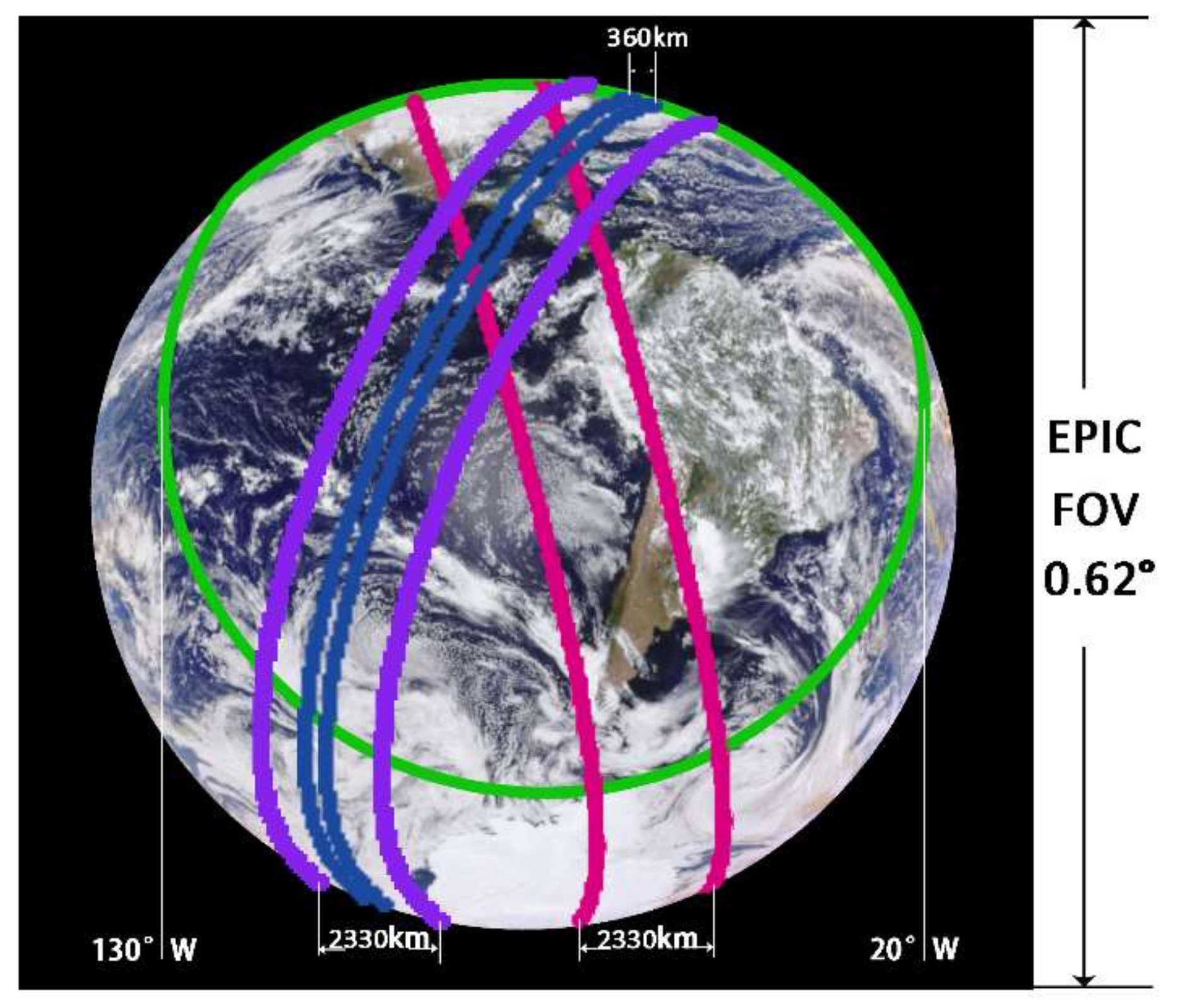
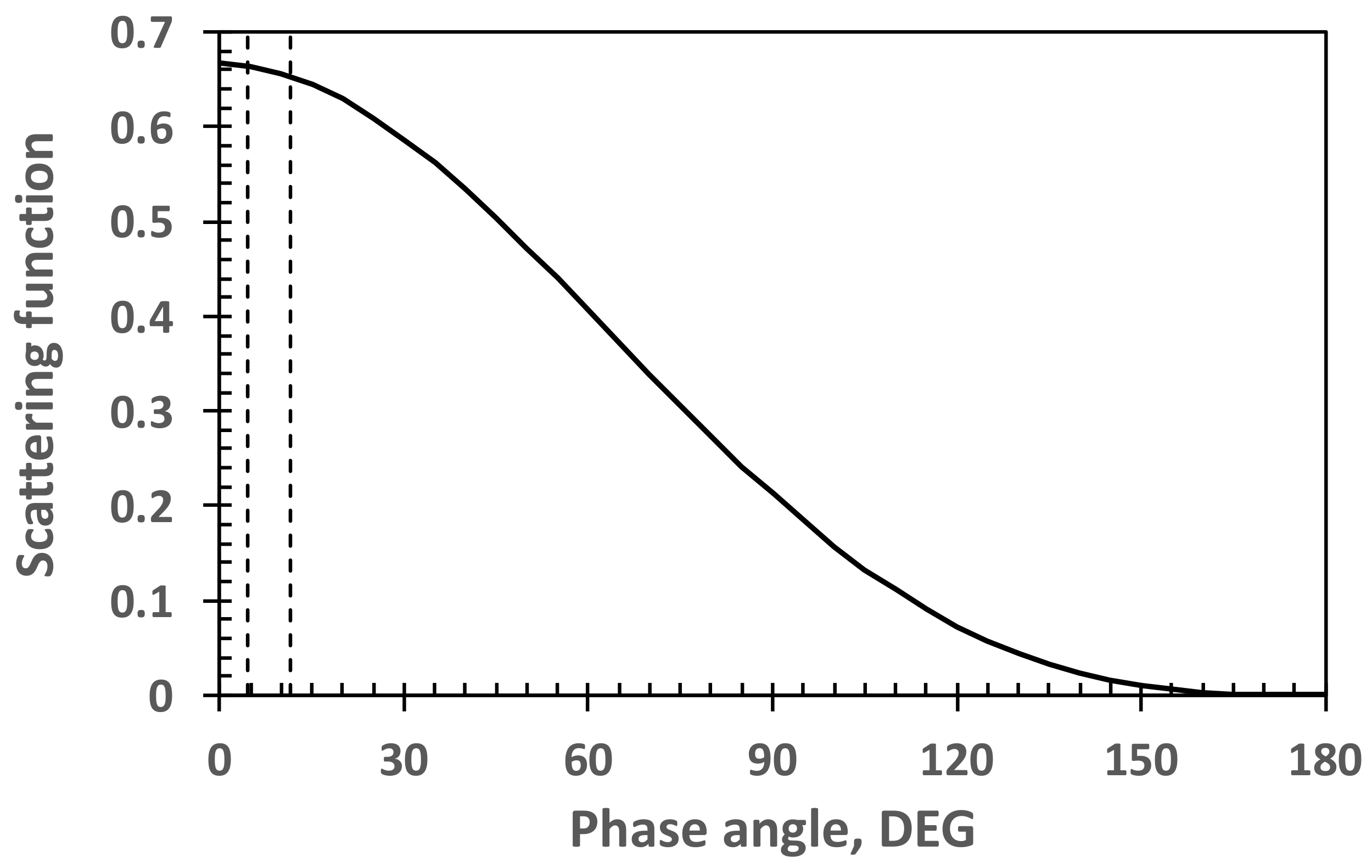
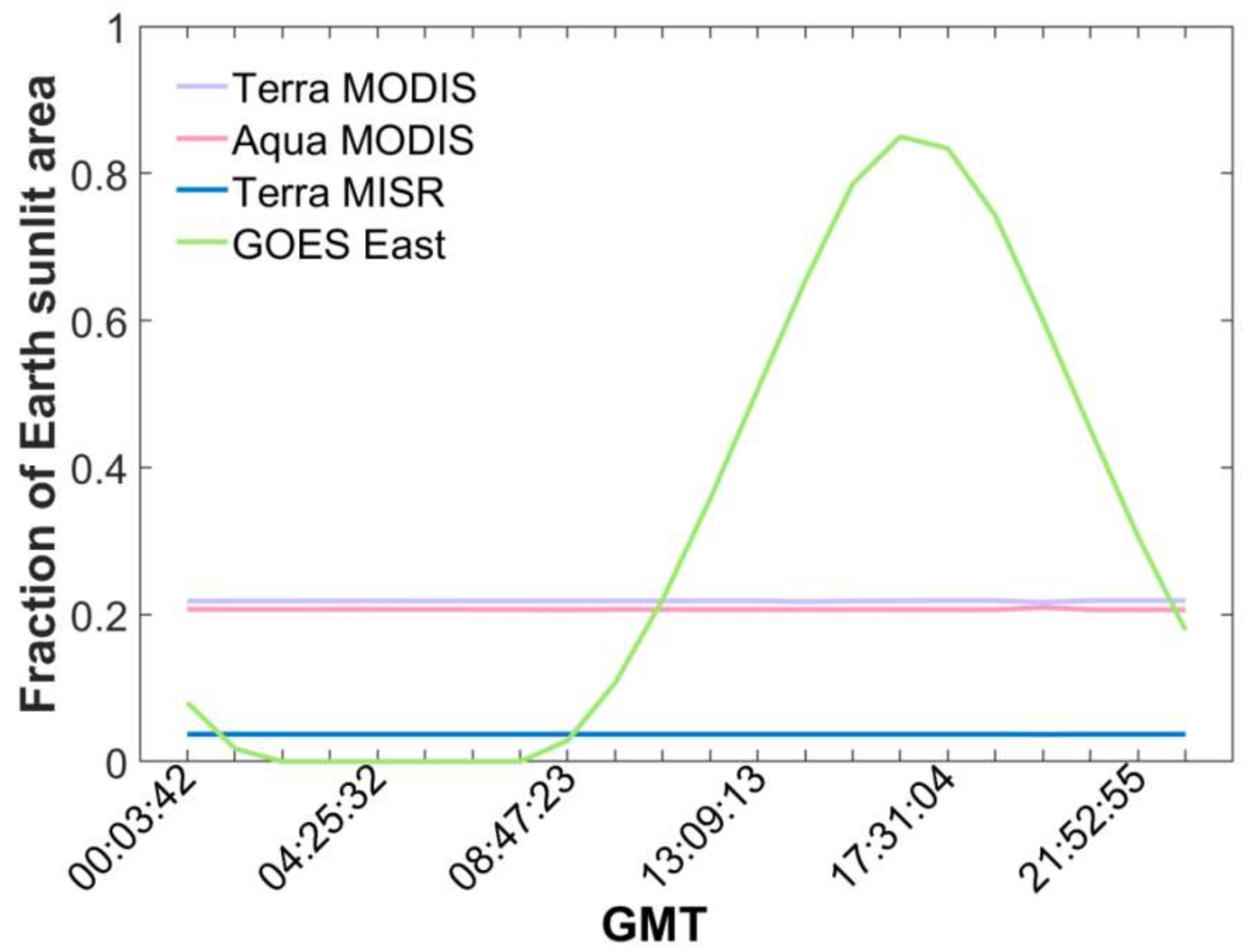
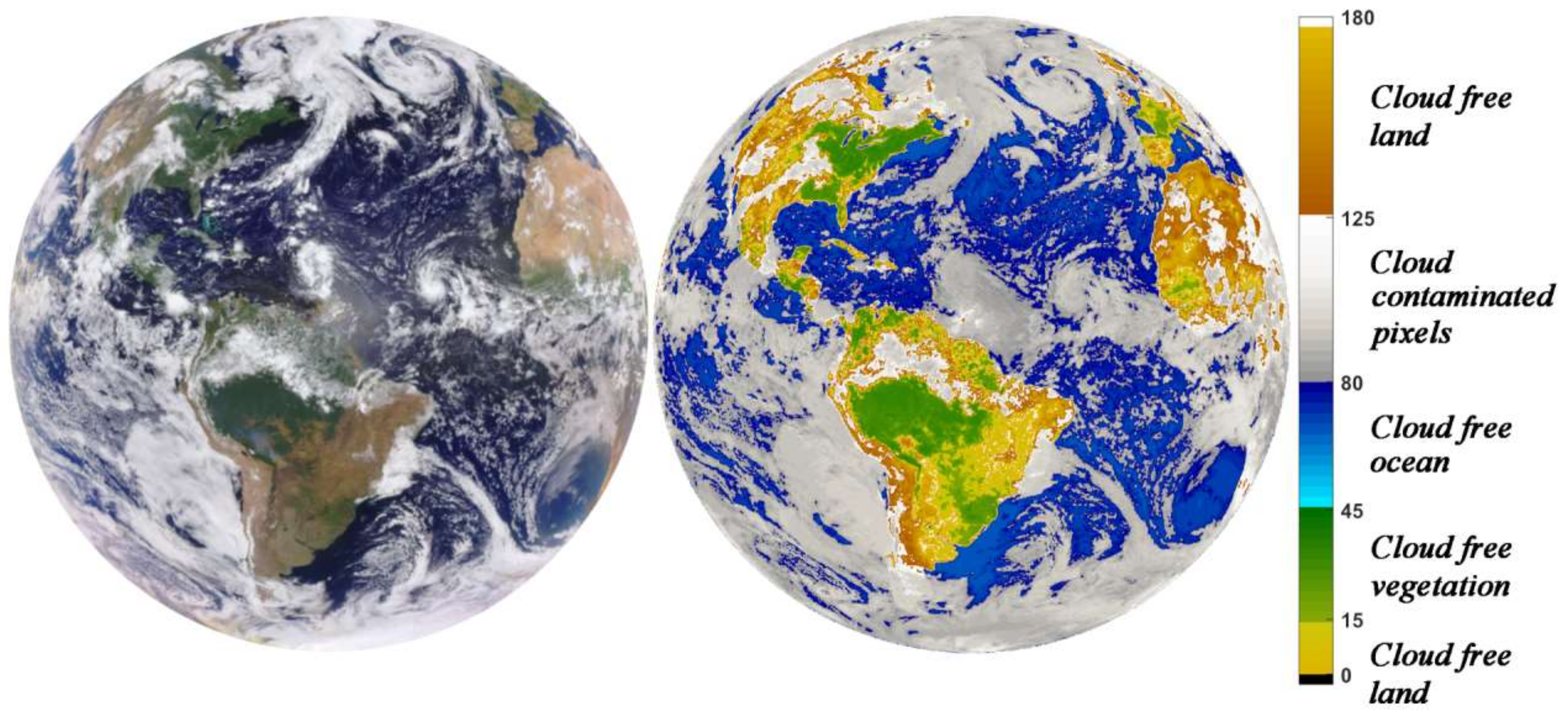
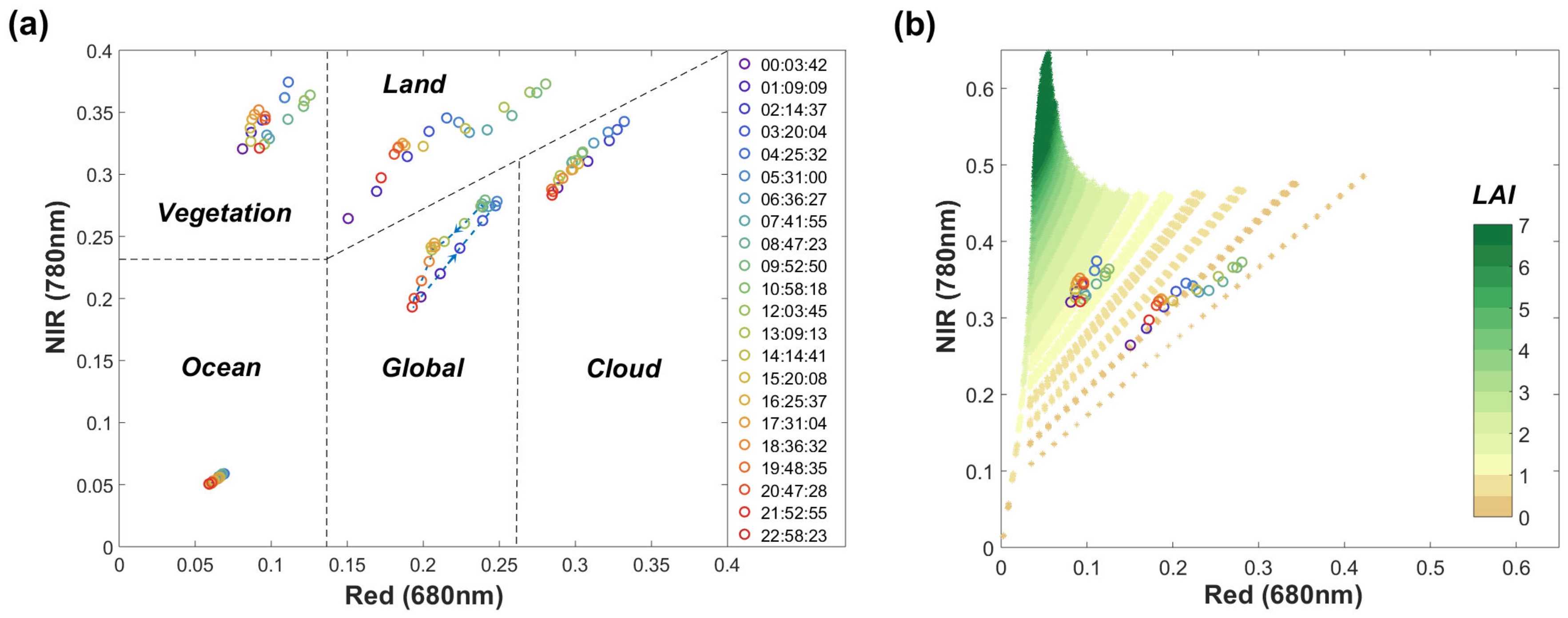
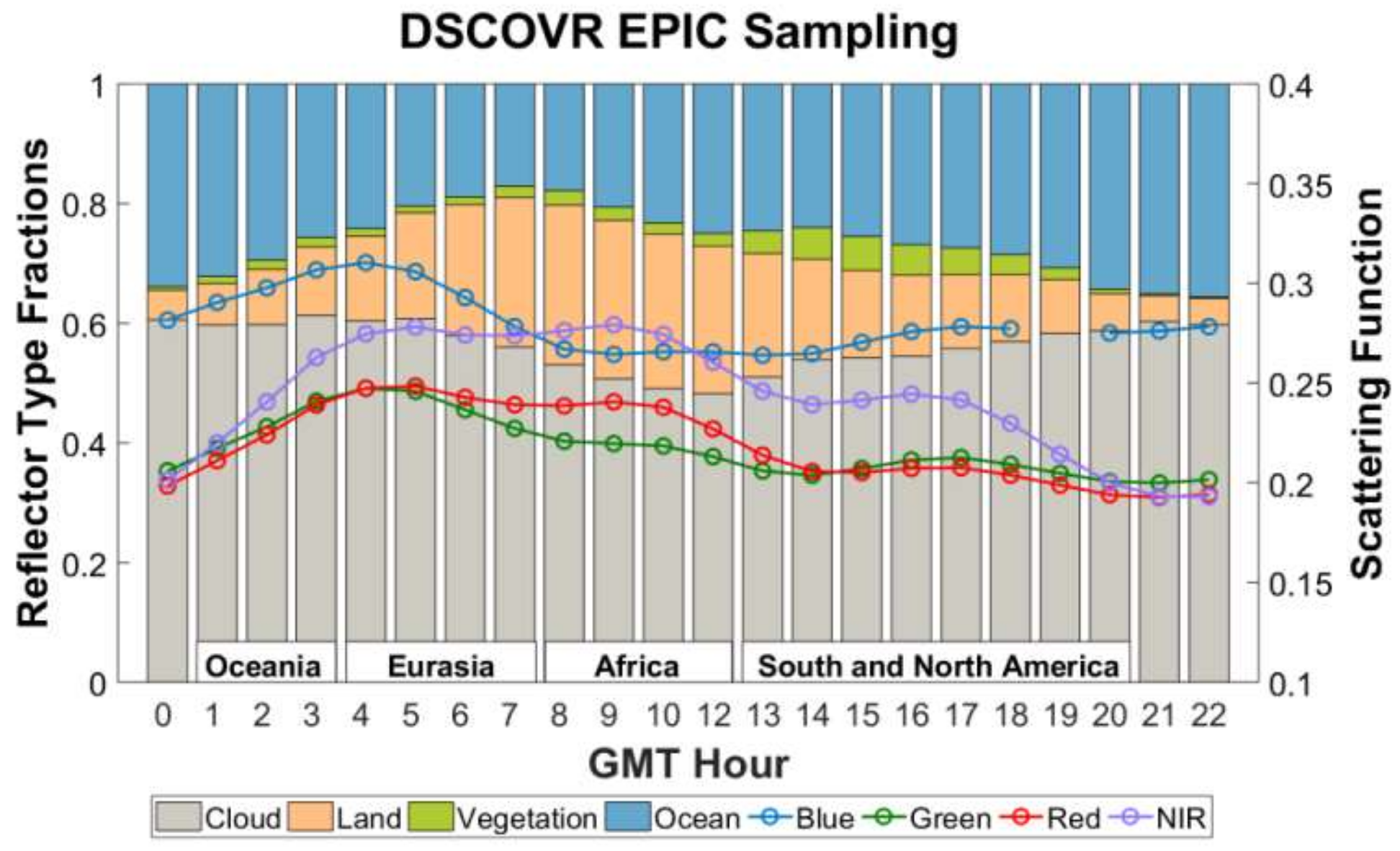
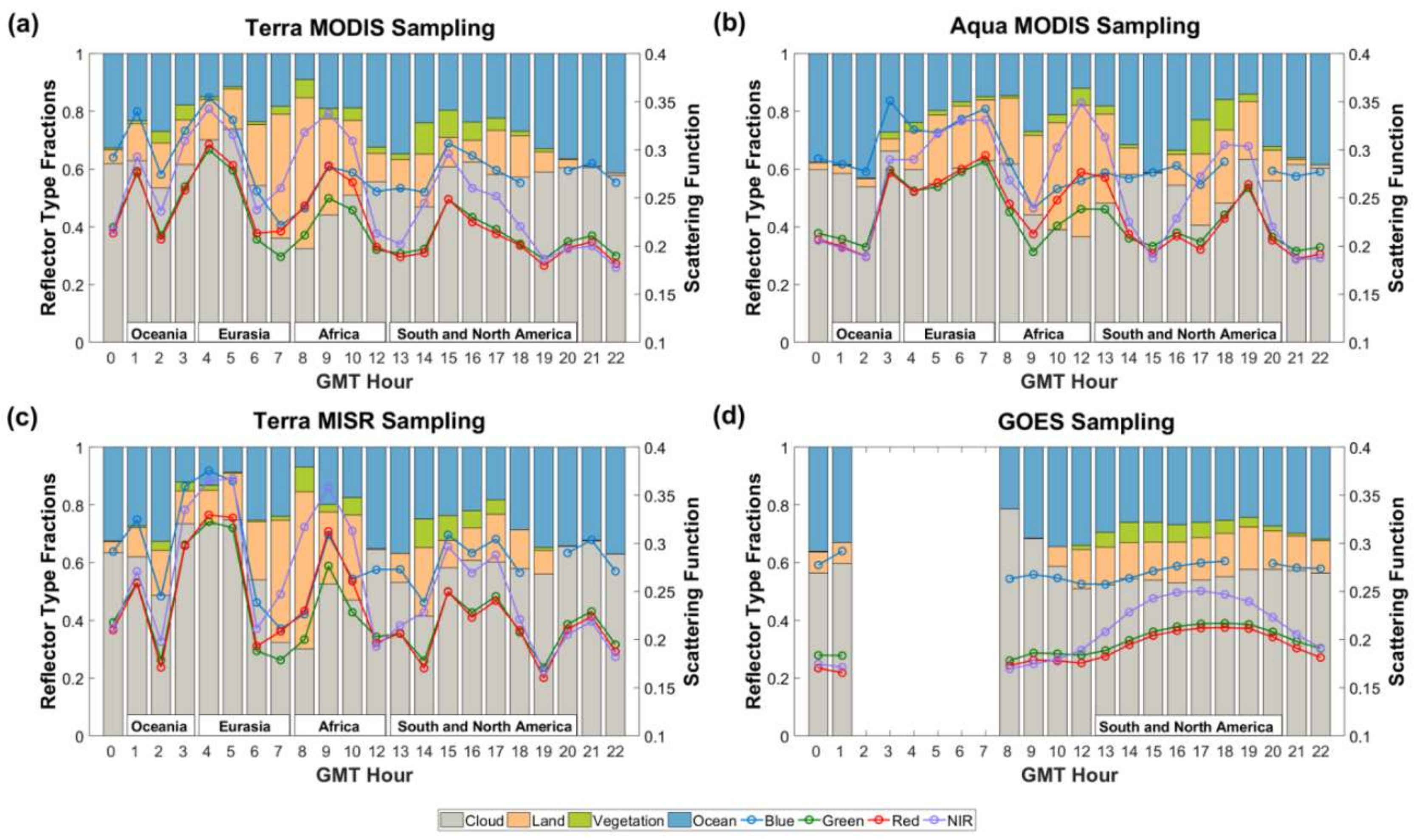
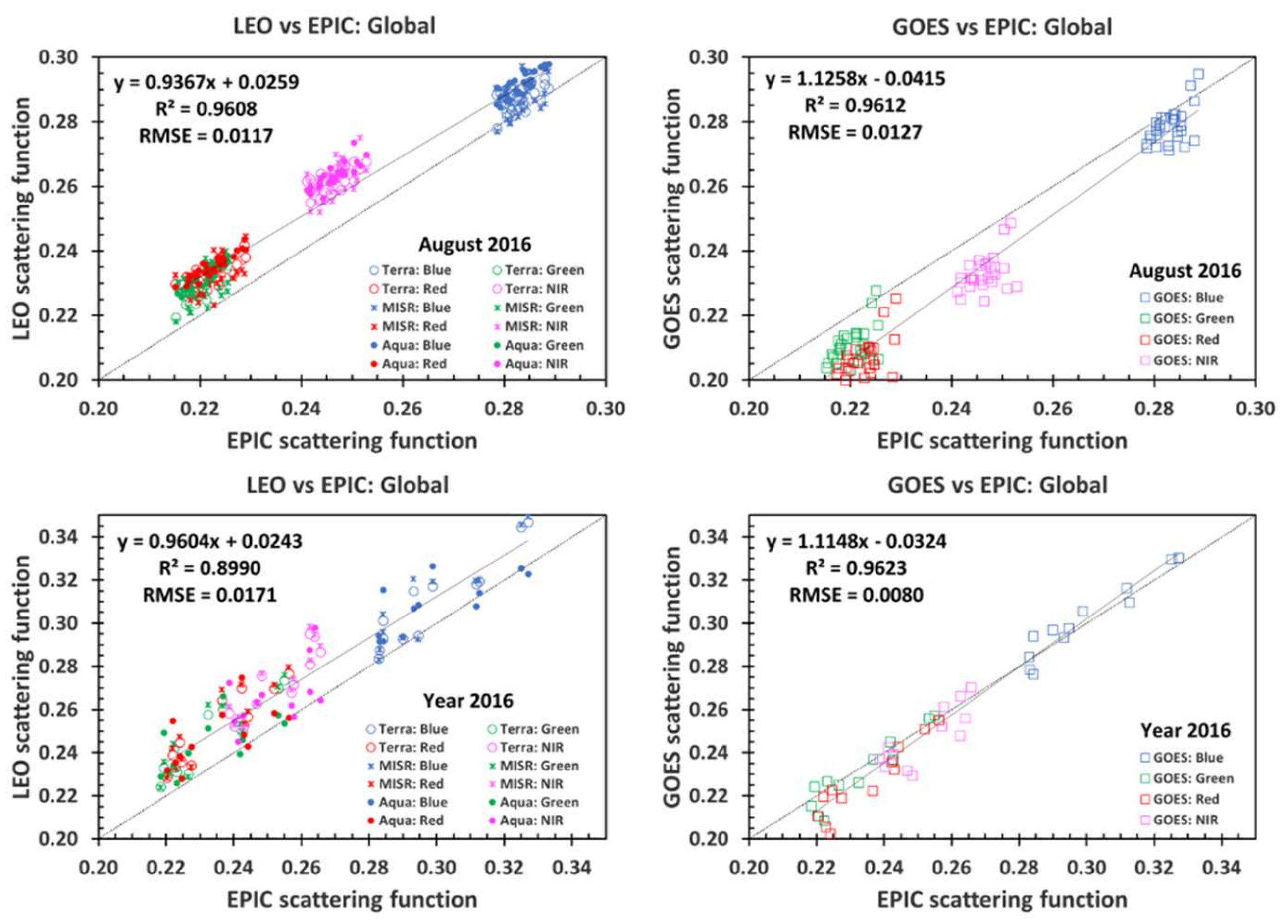
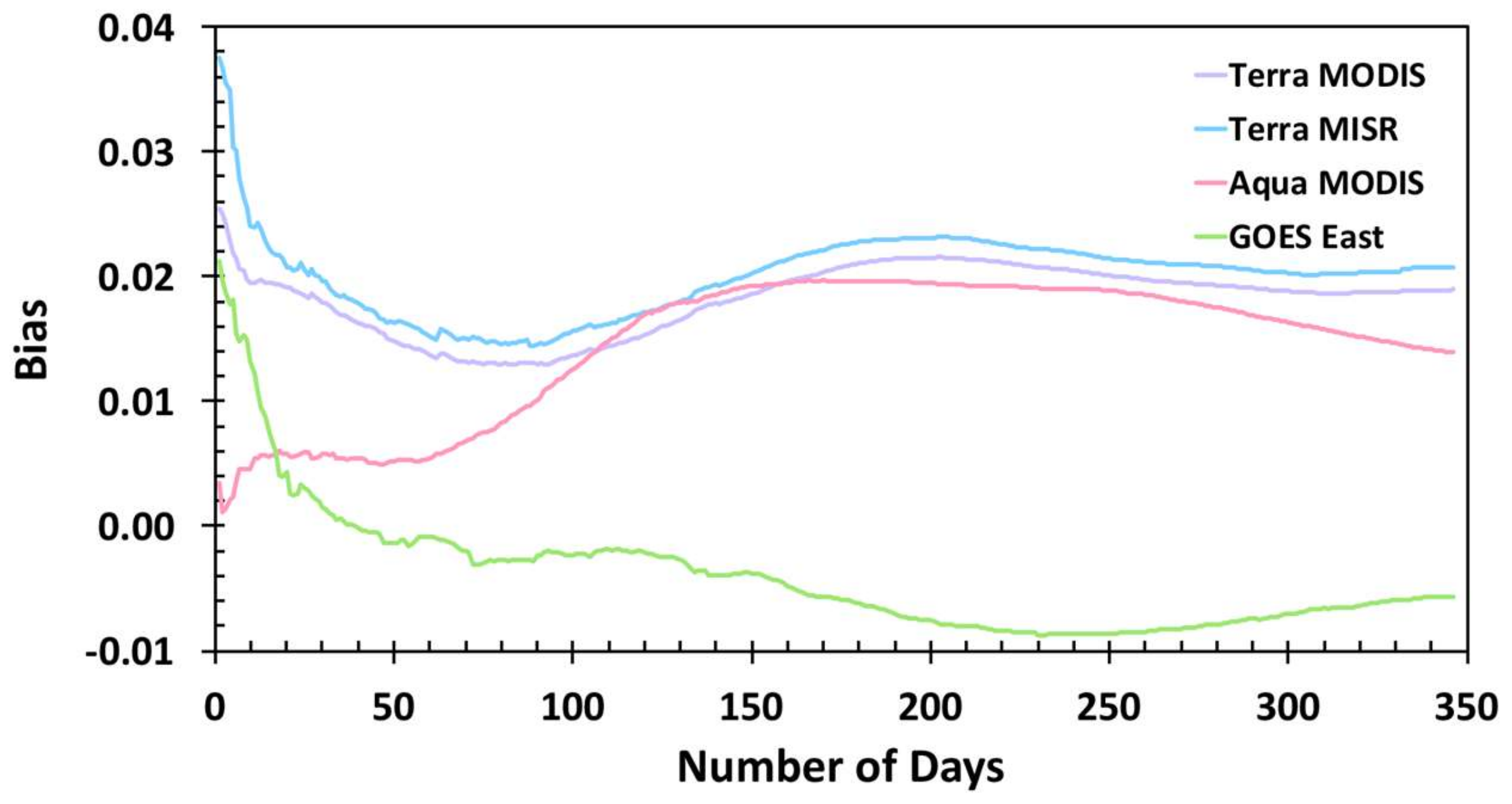
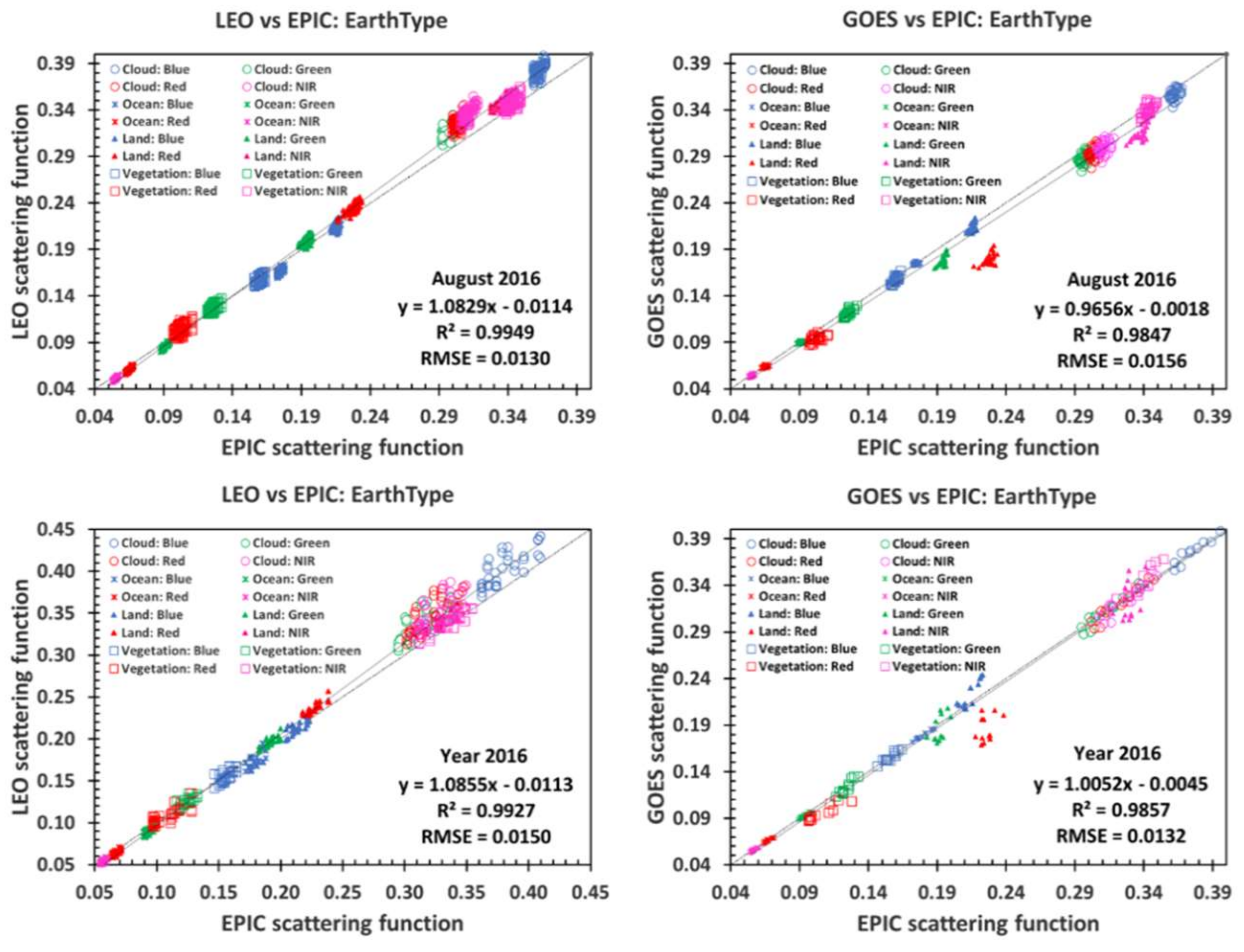


| EPIC Band Number | EPIC Bands Name | EPIC Bands width | Calibration Factors |
|---|---|---|---|
| 5 | Blue | 443 nm | 0.88 × 10−5 |
| 6 | Green | 551 nm | 0.69 × 10−5 |
| 7 | Red | 680 nm | 1.00 × 10−5 |
| 10 | NIR | 780 nm | 1.50 × 10−5 |
| Reflector Type | Variation | Relative Variation, V(S)/V(E) | |||
|---|---|---|---|---|---|
| EPIC Image | Terra MODIS | Terra MISR | Aqua MODIS | GOES-East | |
| Clouds | 0.299 | 4.504 | 6.515 | 4.736 | 1.393 |
| Cloud-free ocean | 0.391 | 3.312 | 3.924 | 3.658 | 1.017 |
| Cloud-free land | 0.447 | 3.120 | 4.187 | 3.229 | 0.558 |
| Cloud-free vegetation | 0.132 | 3.104 | 3.927 | 3.020 | 1.071 |
| Cloud-free surface (land + vegetation) | 0.490 | 3.546 | 4.651 | 3.662 | 0.673 |
| Sampling | Wavelength, nm | |||||||||||
|---|---|---|---|---|---|---|---|---|---|---|---|---|
| 443 | 551 | 680 | 780 | 443 | 551 | 680 | 780 | 443 | 551 | 680 | 780 | |
| Mean | Precision | Variation | ||||||||||
| DSCOVR EPIC | 0.280 | 0.217 | 0.219 | 0.244 | 0.125 | 0.123 | 0.138 | 0.149 | 0.100 | 0.113 | 0.120 | 0.192 |
| Relative bias1(%) | Precision | Relative variation, V(S)/V(E) | ||||||||||
| Terra MODIS | 0.84 | 2.89 | 3.74 | 4.98 | 0.138 | 0.137 | 0.153 | 0.166 | 5.670 | 5.602 | 5.833 | 4.479 |
| Terra MISR | 2.44 | 4.50 | 5.38 | 5.98 | 0.141 | 0.140 | 0.157 | 0.169 | 8.010 | 8.071 | 8.667 | 6.042 |
| Aqua MODIS | 2.91 | 5.31 | 6.05 | 7.11 | 0.132 | 0.132 | 0.149 | 0.162 | 3.736 | 4.317 | 4.920 | 4.051 |
| GOES-East | -11.59 | -5.45 | -8.67 | -6.01 | 0.136 | 0.116 | 0.128 | 0.138 | 0.624 | 0.684 | 0.769 | 0.835 |
| EPIC Spectral Bands | Cloud | Ocean | Land | Vegetation |
|---|---|---|---|---|
| Blue (443 nm) | 76.0 | 15.9 | 9.0 | 0.7 |
| Green (551 nm) | 80.2 | 10.6 | 10.4 | 0.7 |
| Red (680 nm) | 81.7 | 7.5 | 12.1 | 0.6 |
| NIR (780 nm) | 77.2 | 5.9 | 16.4 | 1.8 |
© 2018 by the authors. Licensee MDPI, Basel, Switzerland. This article is an open access article distributed under the terms and conditions of the Creative Commons Attribution (CC BY) license (http://creativecommons.org/licenses/by/4.0/).
Share and Cite
Song, W.; Knyazikhin, Y.; Wen, G.; Marshak, A.; Mõttus, M.; Yan, K.; Yang, B.; Xu, B.; Park, T.; Chen, C.; et al. Implications of Whole-Disc DSCOVR EPIC Spectral Observations for Estimating Earth’s Spectral Reflectivity Based on Low-Earth-Orbiting and Geostationary Observations. Remote Sens. 2018, 10, 1594. https://doi.org/10.3390/rs10101594
Song W, Knyazikhin Y, Wen G, Marshak A, Mõttus M, Yan K, Yang B, Xu B, Park T, Chen C, et al. Implications of Whole-Disc DSCOVR EPIC Spectral Observations for Estimating Earth’s Spectral Reflectivity Based on Low-Earth-Orbiting and Geostationary Observations. Remote Sensing. 2018; 10(10):1594. https://doi.org/10.3390/rs10101594
Chicago/Turabian StyleSong, Wanjuan, Yuri Knyazikhin, Guoyong Wen, Alexander Marshak, Matti Mõttus, Kai Yan, Bin Yang, Baodong Xu, Taejin Park, Chi Chen, and et al. 2018. "Implications of Whole-Disc DSCOVR EPIC Spectral Observations for Estimating Earth’s Spectral Reflectivity Based on Low-Earth-Orbiting and Geostationary Observations" Remote Sensing 10, no. 10: 1594. https://doi.org/10.3390/rs10101594
APA StyleSong, W., Knyazikhin, Y., Wen, G., Marshak, A., Mõttus, M., Yan, K., Yang, B., Xu, B., Park, T., Chen, C., Zeng, Y., Yan, G., Mu, X., & Myneni, R. B. (2018). Implications of Whole-Disc DSCOVR EPIC Spectral Observations for Estimating Earth’s Spectral Reflectivity Based on Low-Earth-Orbiting and Geostationary Observations. Remote Sensing, 10(10), 1594. https://doi.org/10.3390/rs10101594









